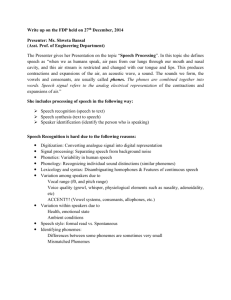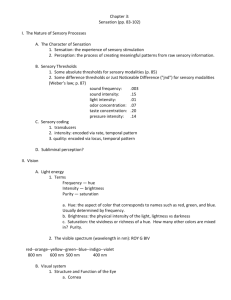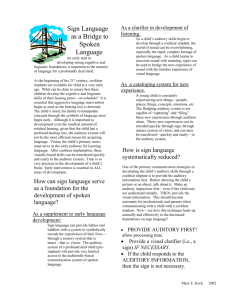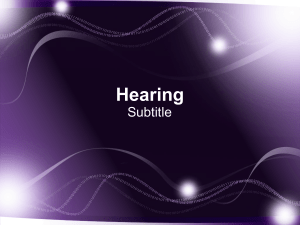Ch09 Lecture Part II
advertisement
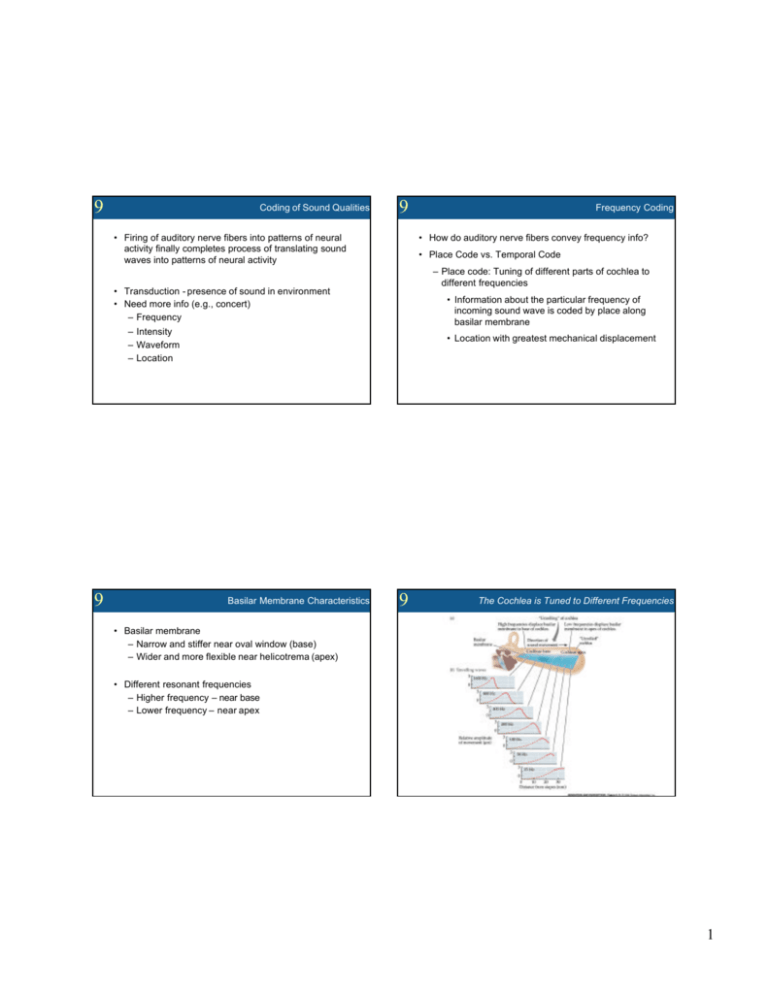
9 Coding of Sound Qualities 9 • Firing of auditory nerve fibers into patterns of neural activity finally completes process of translating sound waves into patterns of neural activity • How do auditory nerve fibers convey frequency info? • Place Code vs. Temporal Code – Place code: Tuning of different parts of cochlea to different frequencies • Transduction - presence of sound in environment • Need more info (e.g., concert) – Frequency – Intensity – Waveform – Location 9 Basilar Membrane Characteristics Frequency Coding • Information about the particular frequency of incoming sound wave is coded by place along basilar membrane • Location with greatest mechanical displacement 9 The Cochlea is Tuned to Different Frequencies • Basilar membrane – Narrow and stiffer near oval window (base) – Wider and more flexible near helicotrema (apex) • Different resonant frequencies – Higher frequency – near base – Lower frequency – near apex 1 9 Inner and Outer Hair Cells 9 • Inner hair cells: Convey almost all information about sound waves to brain • The auditory nerve – Responses of individual AN fibers to different frequencies are related to their place along the cochlear partition – 10-30 AN fibers synapse on each IHC – Most of the sensory information comes from IHC – Frequency selectivity: Clearest when sounds are very faint • Outer hair cells: – Feedback -- controls stereocilia – Threshold tuning curve: Map plotting thresholds of a neuron or fiber in response to sine waves with varying frequencies at lowest intensity that will give rise to a response – Modulate movement of basilar membrane – “Sharpen ” wave envelopes 9 Basic Structure of the Mammalian Auditory System (cont’d) Threshold Tuning Curves 9 Rate Saturation • Rate saturation – Are AN fibers as selective for their characteristic frequencies at levels well above threshold as they are for the barely audible sounds? – Isointensity curves: Chart AN fiber’s firing rate to wide range of frequencies, all presented at same intensity level – Rate saturation: Point at which a nerve fiber is firing as rapidly as possible and further stimulation is incapable of increasing the firing rate 2 9 Isointensity Functions 9 Rate Saturation • Potential problem: Lose information about frequency? • Rate intensity function: A map plotting firing rate of an auditory nerve fiber in response to a sound of constant frequency at increasing intensities • Multiple AN fibers synapse with each inner hair cell • The AN fibers have different dynamic ranges – High spontaneous fibers • More sensitive – saturate at lower intensities – Low spontaneous fibers • Less sensitive – saturate at higher intensities – Range of neurons in between between 9 Firing Rate vs. Sound Intensity 9 Intensity and Firing Rate • At higher intensities – Low spontaneous rate neurons won’t saturate – Will still provide precise information about frequency • Firing rate can be used to convey information about intensity – Some AN fibers respond 0 -25 dB – Other AN fibers 15-40 dB – Other AN fibers 30-55 dB – Etc. – Gives more precise info about intensity • Will be important for sound localization 3 9 Temporal Code for Frequency 9 Neural Spikes 9 Volley Principle • Temporal code for sound frequency – Auditory system has another way to encode frequency aside from the cochlear place code – Phase locking: Firing of a single neuron at one distinct point in the period (cycle) of a sound wave at a given frequency – Existence of phase locking: Firing pattern of an AN fiber carries a temporal code • 100 Hz sound – AN fiber fires at 100 Hz 9 Temporal Code • Problem with temporal code • AN fibers – absolute refractory period – Can only fire so fast (~500 Hz) – Can’t follow higher frequencies • The volley principle: neurons fire at a distinct point in the period of a sound wave but does not fire on every period 4 9 Place theory problem 9 • Place Coding Problem – Low frequencies -- peak off of Basilar Membrane – “run out of room” – Ambiguous low frequency information • Temporal Code Problem – Can’t follow high frequencies – Even with volley principle Which is being used? • • • • Both are operating Frequency theory -- low frequencies Place theory -- high frequencies Both -- intermediate frequencies Frequency Theory Place Theory 20 50 125 250 500 1000 2000 4000 8000 16,000 20,000 Stimulus Frequency (Hz) 9 Auditory System Pathways • Auditory brain structures – AN fibers carries signals from cochlea to brain stem – All AN fibers initially synapse in cochlear nucleus 9 Organization • Tonotopic organization: An arrangement in which neurons that respond to different frequencies are organized anatomically in order of frequency – Maintained in primary auditory cortex (A1) – Neurons from A1 project to belt area, then to parabelt area – Superior olive, inferior colliculus, and medial geniculate nucleus all play roles in auditory process 5 9 The First Stages of Auditory Processing 9 Basic Structure of the Mammalian Auditory System (cont’d) • Comparing overall structure of auditory and visual systems – Auditory system: Large proportion of processing is done before A1 – Visual system: Large proportion of processing occurs beyond V1 – Differences may be due to evolutionary reasons 9 Basic Operating Characteristics of the Auditory System • Psychoacoustics: The study of the psychological correlates of the physical dimensions of acoustics; a branch of psychophysics • Distinction between physical and psychological – Frequency and pitch – Intensity and loudness • Example: Relationship between intensity and loudness (need to take frequency into consideration) 9 Equal Loudness Contours • Procedure: – Standard tone (e.g., 1000 Hz at 40 dB) – Comparison tone (e.g., 100 Hz) • Adjust intensity of comparison • Loudness match – Repeat for other frequencies (e.g., 100, 500, . . . , 3000, 5000) – Record “matching” intensity for each – Set of sounds -- Matched in loudness • Equal loudness contour 6 9 Equal Loudness Demo 9 • Audibility threshold: A map of just barely audible tones of varying frequencies • Web Demo 125 Hz 1000 Hz Intensity and Loudness 3000 Hz “46” “44” “42” “40” “38” “36” 9 Hearing Loss • Hearing can be impaired by damage to any of structures along chain of auditory processing – Obstructing the ear canal results in temporary hearing loss (e.g., earplugs) 9 Hearing Impairments • Review Transduction – Air pressure fluctuations – Action potentials in auditory nerve fibers – Excessive buildup of ear wax (cerumen) in ear canal – Conductive hearing loss: Caused by problems with the bones of the middle ear, (e.g., during ear infections, otitis media) – Otosclerosis: More serious type of conductive loss. Caused by abnormal growth of middle ear bones; can be remedied by surgery 7 9 Hearing impairments 9 Conductive & Sensorineural Hearing Loss 9 Sensorineural Hearing Loss • Problems in any stage – Hearing impairment • Two categories – Conductive hearing loss – Sensorineural hearing loss 9 Conductive Hearing Loss • Problems transmitting pressure waves to cochlear fluid • Variety of causes – Swimmer’s ear -- swelling of ear canal – Ruptured tympanic membrane – Otitis media • Middle ear infection • Fluid fills middle ear – Otosclerosis • Abnormal bone growth -- ossicles fused in place • Loss: All frequencies • Problems in transduction or transmission • Caused by – Hair cell damage • Abrupt noise • Prolonged exposure • Some drugs -- ototoxic • Presbycusis -- old hearing – Tumors along auditory pathway • Auditory nerve • Nuclei of brainstem • Loss: Frequency specific 8 9 Hearing Evaluations 9 Audiogram 9 Conductive Hearing Loss • Pure-tone Audiometry – Use pure tones -- sine waves (single frequency) – Measures absolute threshold across range of frequencies – Variant of Method of Limits – Create Audiogram • Threshold relative to normal • Test range of frequencies • Headphones (air conduction) 9 Hearing Evaluations • Bone conduction – Cochlea -- cavity in skull – Sound - vibrations in cochlear fluid – Vibrate skull -- vibrate fluid • Beethoven • Air conduction XO – Increased threshold – All frequencies • Bone conduction [ ] – normal thresholds – Vibrate skull at different frequencies – Create Bone -conduction Audiogram 9 9 Sensorineural Hearing Loss 9 Presbycusis •“Old hearing” •Sensorineural hearing loss •Increase in threshold –More pronounced for high frequencies –Damage to hair cells (years of wear and tear) • Air Conduction XO – Increased thresholds – Frequency specific • Bone conduction – Same pattern 9 Hearing Loss in Easter Islanders 9 Cochlear Implant • Environmental Contributions to Presbycusis – Sex differences – Location differences 10


